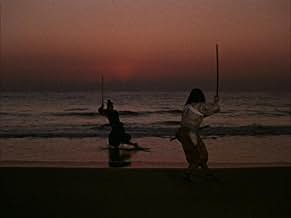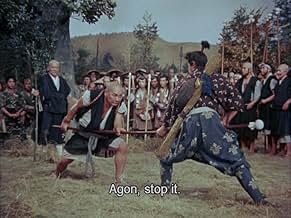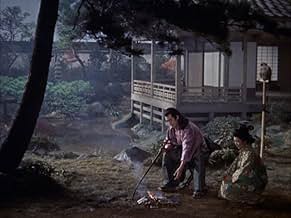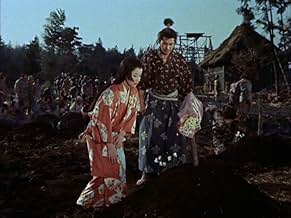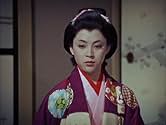CALIFICACIÓN DE IMDb
7.5/10
7 k
TU CALIFICACIÓN
Agrega una trama en tu idiomaMusashi Miyamoto is challenged to a duel by a confident swordsman Sasaki Kojiro. He agrees to fight him in a year's time.Musashi Miyamoto is challenged to a duel by a confident swordsman Sasaki Kojiro. He agrees to fight him in a year's time.Musashi Miyamoto is challenged to a duel by a confident swordsman Sasaki Kojiro. He agrees to fight him in a year's time.
- Dirección
- Guionistas
- Elenco
Opiniones destacadas
This is the 3rd and last episode of the "Miyamoto Musashi" or also called "Samourai" trilogy, from director Inagaki with famous Japanese actor Toshiro Mifune. The 1st episode having won the 1956 Oscar award of best foreign movie ! Inagaki's directing is refined and perfect, scenery is beautiful especially the sunset duel, choreography of combats is marvellous. Inagaki's directing and Mifune's great acting bring life to Musashi's legend and depict him with a lot of humanity.
This episode has the most significance for Japanese with the famous combat between Miyamoto Mifune, invincible samourai of more than 60 duels armed with a wooden sword, and Sasaki Kojiro, most formidable adversary and skillful swordsman armed with an extremely long sword, on the beach of Ganryu Island at sunset. The trilogy shows the life of Japan's most famous samourai and one of it's main philosopher, with the "Gorin-no-sho" treaty of 5 rings, with his sword techniques and Budhism life philosophy. In summary, the 1st episode is how he becomes an adult man, the 2nd how he becomes an invincible swordsman and the 3rd how he becomes a legend. Subplots being his relationship with Otsu who sacrifices her life for Musashi.
This trilogy is among Japan's two samourai masterpieces with Kurosawa's "Seven Samurais", mainly because of the directing/acting and Musashi's aura. Other Must-see Sword movies are recent movie Gohatto (or Tabou, 1999), Kurosawa's "Ame agaru" (After the rain, 1999), "Yojimbo" (The bodyguard) and "Sugata Sanshiro" (The Judo saga).
This episode has the most significance for Japanese with the famous combat between Miyamoto Mifune, invincible samourai of more than 60 duels armed with a wooden sword, and Sasaki Kojiro, most formidable adversary and skillful swordsman armed with an extremely long sword, on the beach of Ganryu Island at sunset. The trilogy shows the life of Japan's most famous samourai and one of it's main philosopher, with the "Gorin-no-sho" treaty of 5 rings, with his sword techniques and Budhism life philosophy. In summary, the 1st episode is how he becomes an adult man, the 2nd how he becomes an invincible swordsman and the 3rd how he becomes a legend. Subplots being his relationship with Otsu who sacrifices her life for Musashi.
This trilogy is among Japan's two samourai masterpieces with Kurosawa's "Seven Samurais", mainly because of the directing/acting and Musashi's aura. Other Must-see Sword movies are recent movie Gohatto (or Tabou, 1999), Kurosawa's "Ame agaru" (After the rain, 1999), "Yojimbo" (The bodyguard) and "Sugata Sanshiro" (The Judo saga).
Samurai III: Duel on Ganryu Island is the closing film of Inagaki's Samurai trilogy, the story of Musashi Miyamoto (Mifune). It is one of the best samurai films on its own and has the advantage of having the characters' history established in the first two films of the trilogy. This film abounds in good characters: Musashi's two disciples, a young boy and a horse trader, who exchange good natured barbs and loyally support Musashi; the two women in Musashi's life, good girl Otsu and bad girl Akemi; the brigand leader and his henchman, who was formerly Akemi's stepfather; and of course, Musashi's nemesis, Kojiro Sasaki, who is outstanding in both this film and Samurai II. Kojiro is actually a more interesting character than Musashi and reminds me of Tatsuya Nakadai's performance in Sword of Doom. The climactic duel on the beach with the rising sun in the background is amazing. Side note: This film has four of Kurosawa's Seven Samurai actors: Mifune, Shimura, Kato and Chiaki. See the whole trilogy.
1st watched 4/19/2003 - 7 out of 10(Dir-Hiroshi Inagaki): Sweeping romantic Hollywood-like epic from Japan that just happens to be about a Samurai. This is the last in a trilogy of films about Mr. Musashi(played by Toshiru Mifune) and his Samurai journeys. This one plays more like a romantic piece with two women fighting(bawling & brawling) over the affections of this strong-willed but soft-hearted hero and brave warrior. It's awesome to see a film made in Japan where the warrior hero cares about more than killing his opponent. The obvious issue of honor is foremost in this Samurai's mind and the killing just comes with the job. So many films that Americans were introduced to from Japan were either silly Godzilla-type movies or karate flicks(with almost no heart, but a lot of fighting). This is the kind of movie that Japan is probably very proud of, but is not often seen by American audiences. Bravo to Criterion for putting this into their DVD collection!! Now I'd just like to see the 1st two pictures in the trilogy to know more about what happened to the characters prior to this film. The climatic duel is also `one-of-a-kind' and has to be seen to be appreciated. I'll just leave it at that without giving too much away. Give this one a shot, you'll be glad you did!
This film is the final installment of director Hiroshi Inagaki's "Samurai Trilogy," three films covering the life of Musashi Miyamoto (Takezo,) Japan's most famous swordsman of the early 17th century and perhaps of all time.
He was an icon of the warrior-philosopher model. He survived numerous duels to the death and retired to painting and writing. His best known work is the "Book of Five Rings," a book which gained popularity recently when it was championed by the Harvard Business School.
All three films of Inagaki's trilogy, made in 1954, 1955, and 1956, are part of the elite Criterion Collection of classic films.
Briefly, this movie resolves the conflict of the two women in Takezo's life, Otsu and Akemi, and leads up to Musashi's showdown with the second most famous swordsman of the day, Sasaki Kojiro. This is the famous Duel at Ganryu Island of the title.
Although I cannot appreciate the Japanese language and must rely on the English subtitles for the meaning of dialog, I do appreciate the beauty of this early widescreen color film. (I believe Tojoscope is a Japanese version of cinemascope.) One could take almost every frame of this film and it would make a stunning still. The costumes and the sets reflect an attention to detail of color, lighting and composition.
For its sense of rather understated action, I particularly enjoyed the opening scene. Sasaki Kojiro demonstrates his signature Swallowtail Turn, a move whereby he severs the tail feathers of this notably swift and agile bird in flight. It's not the portrayed animal cruelty that I enjoyed; it's the human quickness and skill that would be required to accomplish such a feat. I certainly hope that no birds were actually harmed in the making of the film.
He was an icon of the warrior-philosopher model. He survived numerous duels to the death and retired to painting and writing. His best known work is the "Book of Five Rings," a book which gained popularity recently when it was championed by the Harvard Business School.
All three films of Inagaki's trilogy, made in 1954, 1955, and 1956, are part of the elite Criterion Collection of classic films.
Briefly, this movie resolves the conflict of the two women in Takezo's life, Otsu and Akemi, and leads up to Musashi's showdown with the second most famous swordsman of the day, Sasaki Kojiro. This is the famous Duel at Ganryu Island of the title.
Although I cannot appreciate the Japanese language and must rely on the English subtitles for the meaning of dialog, I do appreciate the beauty of this early widescreen color film. (I believe Tojoscope is a Japanese version of cinemascope.) One could take almost every frame of this film and it would make a stunning still. The costumes and the sets reflect an attention to detail of color, lighting and composition.
For its sense of rather understated action, I particularly enjoyed the opening scene. Sasaki Kojiro demonstrates his signature Swallowtail Turn, a move whereby he severs the tail feathers of this notably swift and agile bird in flight. It's not the portrayed animal cruelty that I enjoyed; it's the human quickness and skill that would be required to accomplish such a feat. I certainly hope that no birds were actually harmed in the making of the film.
I have seen the three films in one shot, and I have to say: AMAZING ! Samurai's life is a must know: honor, proud, philosophy it was a way of life. The three films from Inagaki are really great: good photography, well directed moving camera, it really seems that you are eating rice in the middle of the 17th century in Japan. This is also due to the language, its japanese...yes Japanese, but doesn't matter because it's better ! The strength in the talks are only comprehensive in the native language. If you like adventure, historical, romance or action movies you MUST see this three films (cannot be considered one to one). Inagaki received the Oscar in 1955 for Samurai I, thats all. And enjoy!
¿Sabías que…?
- TriviaThis film is part of the Criterion Collection, spine #16.
- ErroresAs the final duel is fought, the duelists have light on the sides of their bodies away from the sun - Sasaki has light on his back and Miyamoto light on his face.
- Citas
Musashi Miyamoto: Brace up, Akemi.
- ConexionesFeatured in Sayonara Jupitâ (1984)
Selecciones populares
Inicia sesión para calificar y agrega a la lista de videos para obtener recomendaciones personalizadas
- How long is Samurai III: Duel at Ganryu Island?Con tecnología de Alexa
Detalles
- Fecha de lanzamiento
- País de origen
- Idioma
- También se conoce como
- Samurai III: Duel at Ganryu Island
- Locaciones de filmación
- Productora
- Ver más créditos de la compañía en IMDbPro
- Tiempo de ejecución1 hora 45 minutos
- Mezcla de sonido
- Relación de aspecto
- 1.37 : 1
Contribuir a esta página
Sugiere una edición o agrega el contenido que falta

Principales brechas de datos
By what name was Miyamoto Musashi kanketsu-hen: Kettô Ganryû-jima (1956) officially released in India in English?
Responda



